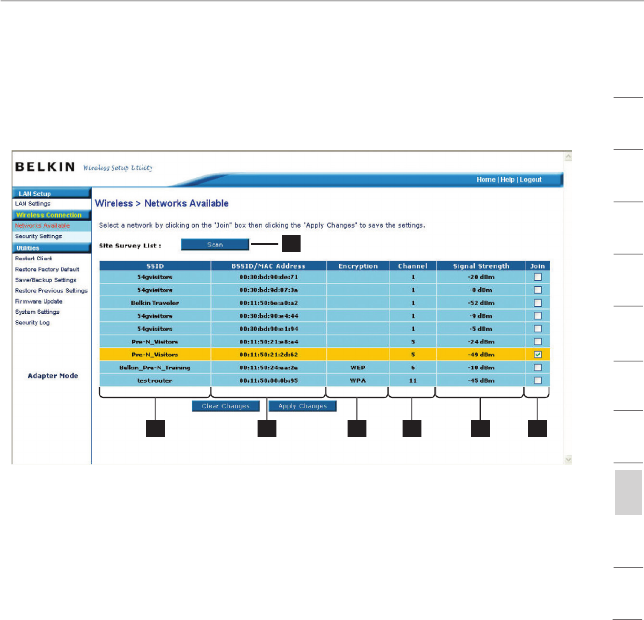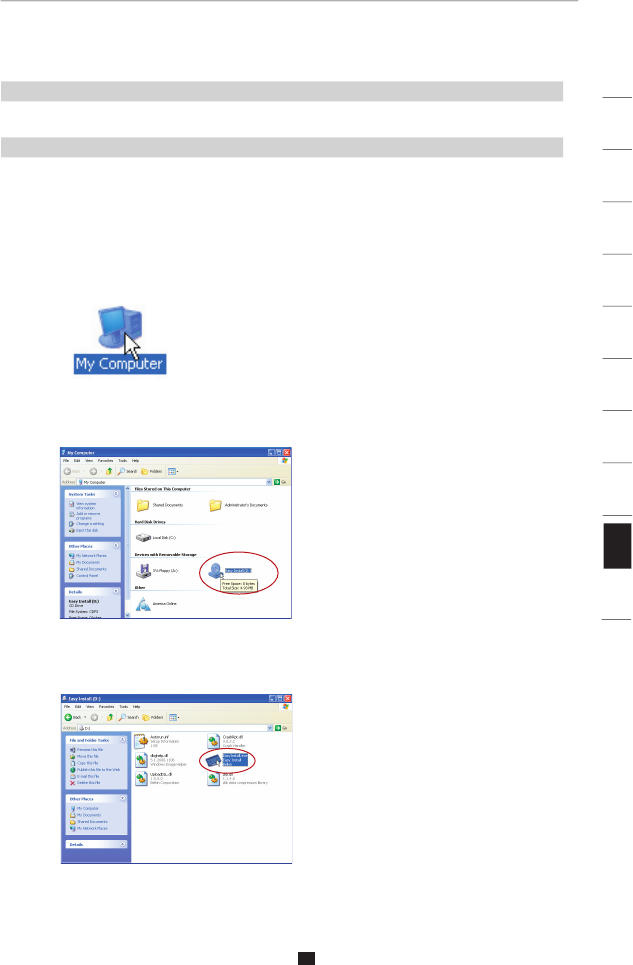Arcadyan Technology WA4001CB WLAN ACCESS POINT User Manual P74841 F5D7233 man indd
Arcadyan Technology Corporation WLAN ACCESS POINT P74841 F5D7233 man indd
Contents
USER MANUAL 7 OF 7

Using the Adapter Mode
71
Using the Adapter Mode
section
2
1
3
4
5
6
7
8
9
10
11
Using the Adapter Mode
Connect to a Wireless Network
Click “Networks Available” from the quick-navigation links.
Site Survey List
1. Scan
Clicking the “Scan” button will give you the most up-to-date data
list of available networks.
2. SSID
The SSID is the wireless network name.
3. BSSID/MAC Address
This gives the MAC address of the available network.
4. Encryption
Identifies the type of network security implemented (WPA or
WEP). This field will show a blank if the network is unsecured.
5. Channel
Identifies which channel the network is on.
6. Signal Strength
Provides a measurement of the networks signal strength.
7. Join
You can connect to a specific wireless network by selecting the
check box and clicking “Apply Changes”.
(1)
(2)
(3)
(4)
(5)
(6)
(7)

Using the Adapter Mode
727272
Troubleshooting
Using the Adapter ModeTroubleshootingUsing the Adapter Mode
Restart Client
You can restart your Router (in Adapter Mode) without losing any of
your configuration settings by clicking “Restart Client”.
Restore Factory Defaults
Clicking “Restore Factory Default” will erase all your current settings.
Save Backup Settings
You can save your current configuration by using this feature. Saving
your configuration will allow you to restore it later if your settings are
lost or changed. It is recommended that you back up your current
configuration before performing a firmware update.
Restore Previous Settings
This option will allow you to restore a previously saved configuration.
Firmware Update
From time to time, Belkin may release new versions of the Router’s
firmware. Updates contain improvements and fixes to known
problems. For the latest firmware, go to the support section of
www.belkin.com/networking.
a. Browse:
Clicking on “Browse” will open a window that allows you to
select the location of the firmware-update file.
b. Upgrade:
Clicking on “Upgrade” will update your Router to the
latest firmware.

Using the Adapter Mode
Troubleshooting
737373
section
2
1
3
4
5
6
7
8
9
10
11
Problem:
Installation CD does not automatically start.
Solution:
If the CD-ROM does not start the Easy Install Wizard automatically,
it could be that the computer is running other applications that are
interfering with the CD drive.
1.
If the Easy Install Wizard screen does not appear within 15—20
seconds, open up your CD-ROM drive by double-clicking on the
“My Computer” icon that is located on your desktop.
2.
Next, double-click on the CD-ROM drive that the Easy Install
Wizard Software CD has been placed in to start the installation.
3.
The Easy Install Wizard should start within a few seconds. If,
instead, a window appears showing the files on the CD,
double-click on the icon labeled “EasyInstall.exe”.

74
Troubleshooting
Troubleshooting
Problem:
The Easy Install Wizard cannot find my Router.
Solution:
If the Easy Install Wizard is not able to find the Router during the
installation process, please check the following items:
1.
Check to see if the switch on the back of the Router has been
set to “Router Mode.”
2.
Unplug power to the Router for 10 seconds, and then plug the
power back into the Router. Ensure that the Router’s “Power”
light is on; it should be solid green. If not, check to make sure
that the AC adapter is correctly connected to the Router and
plugged into a wall outlet.
3.
Check to see if the switch on the back of the Router has been
set to “Router Mode”.
Problem:
The Easy Install Wizard cannot connect my Router to the Internet.
Solution:
If the Easy Install Wizard is not able to connect the Router to the
Internet, please check the following items:
1.
Ensure that you have a cable (use the cable included with the
Router) connected between (1) the Ethernet port on the back of the
Router to the (2) Ethernet port of your modem or service provider.
2.
If your ISP requires a user name and password, make sure that
you have typed in your user name and password correctly. Some
user names require that the ISP’s domain be at the end of the name.
Example: “myname@myisp.com”. The “@myisp.com” part of the
user name may need to be typed as well as your user name.
Problem:
The Easy Install Wizard completed installation and the Router’s
“Ethernet” light is lit “On” but my web browser doesn’t work.
Solution:
1.
Make sure the network cable between the modem and the Router is
connected. We strongly recommend using the cable that was supplied
with your cable or DSL modem for this purpose. The cable should be
connected at one end to the Router’s “Ethernet” port, and at the other
end to the network port on your modem or service provider.

Troubleshooting
75
section
2
1
3
4
5
6
7
8
9
10
11
2.
Unplug the cable or DSL modem from its power source for three
minutes. After three minutes, plug the modem back into its
power source. This may force the modem to properly recognize
the Router.
3.
Unplug the power to your Router, wait 10 seconds, and then
reconnect the power. This will cause the Router to reattempt
communication with the modem.
If the “Ethernet” light on the Router is not lit after completing
these steps, please contact Belkin Technical Support.
4.
Try shutting down and restarting your computer.
5.
If you have a “static IP address” connection, your ISP must
assign you the IP address, subnet mask, and gateway address.
6.
If you have a “PPPoE” connection, your ISP will assign you a
user name and password and sometimes a service name. Make
sure the Router connection type is configured to “PPPoE” and the
settings are entered properly.
7.
You may need to configure your Router to meet the specific
requirements of your ISP. To search our Knowledge Base for
ISP-specific issues, go to: http://web.belkin.com/support and
type in “ISP”.
If you are still unable to access the Internet after verifying these
settings, please contact Belkin Technical Support.
Problem:
I can’t connect to the Internet wirelessly.
Solution:
If you are unable to connect to the Internet from a wireless
computer, please do the following:
1.
Look at the lights on your Router. Your Belkin Router’s lights
should be as follows:
• The “Power” light should be on.
• The “Connected” light should be on and not blinking.
• The “WAN” light should be either on or blinking.

76
Troubleshooting
Troubleshooting
2.
Open your wireless utility software by clicking on the icon in the
system tray at the bottom, right-hand corner of the screen. If you
are also using a Belkin Wireless Card or Adapter with this
Router,
the tray icon should look like this (the icon may be red or green):
3.
The exact window that opens will vary depending on the model
of wireless card you have; however, any of the utilities should
have a list of “Available Networks”—those wireless networks it
can connect to.
Does the name of your wireless network appear in the results?
Yes, my network name is listed
—
go to the troubleshooting
solution titled “I can’t connect to the Internet wirelessly, but my
network name is listed”.
No, my network name is not listed—
go to the troubleshooting
solution titled “I can’t connect to the Internet wirelessly, and my
network name is not listed”.
Problem:
I can’t connect to the Internet wirelessly, but my network name
is listed.
Solution:
If the name of your network is listed in the “Available Networks” list,
please follow the steps below to connect wirelessly:
1.
Click on the correct network name in the “Available Networks” list.
2.
If the network has security (encryption) enabled, you will need to
enter the network key. For more information regarding security,
see the section entitled “Securing your Wi-Fi Network” in this
User Manual.
3.
Within a few seconds, the tray icon in the lower, left-hand
corner of your screen should turn green, indicating a successful
connection to the network.

Troubleshooting
77
section
2
1
3
4
5
6
7
8
9
10
11
Problem:
I can’t connect to the Internet wirelessly, and my network name is
not listed.
Solution:
If the correct network name is not listed under “Available Networks”
in the wireless configuration utility, please attempt the following
troubleshooting steps:
1.
Temporarily move your computer, if possible, five to 10 feet
away from the Router. Close the wireless configuration utility,
and reopen it. If the correct network name now appears under
“Available Networks”, you may have a range or interference
problem. Please see the suggestions discussed in the section
titled “Placement of your Router for Optimal Performance” in this
User Manual.
2.
Using a computer that is connected to the Router through a
network cable (as opposed to wirelessly), ensure that “Broadcast
SSID” is enabled. This setting is found on the Router’s wireless
“Channel and SSID” configuration page.
If you are still unable to access the Internet after completing these
steps, please contact Belkin Technical Support.
Problem:
My wireless network performance is inconsistent.
Data transfer is sometimes slow.
Signal strength is poor.
I am having difficulty establishing and/or maintaining a Virtual
Private Network (VPN) connection.
Solution:
Wireless technology is radio-based, which means connectivity and
the throughput performance between devices decreases when
the distance between devices increases. Other factors that will
cause signal degradation (metal is generally the worst culprit) are
obstructions such as walls and metal appliances. As a result, the
typical indoor range of your wireless devices will be between 100
to 200 feet. Note also that connection speed may decrease as you
move farther away from the Router or access point.

78
Troubleshooting
Troubleshooting
In order to determine if wireless issues are related to range, we
suggest temporarily moving the computer, if possible, five to 10 feet
away from the Router.
Changing the Wireless Channel
—
Depending on local wireless
traffic and interference, switching the wireless channel of your
network can improve performance and reliability. The default
channel the Router is shipped with is channel 11.
Limiting the Wireless Transmit Rate
—
Limiting the wireless
transmit rate can help improve the maximum wireless range, and
connection stability. Most wireless cards have the ability to limit
the transmission rate. To change this property, go to the Windows
Control Panel, open “Network Connections” and double-click on
your wireless card’s connection. In the “Properties” dialog, select
the “Configure” button on the “General” tab (Windows 98 users
will have to select the wireless card in the list box and then click
“Properties”), then choose the “Advanced” tab and select the rate
property. Wireless client cards are usually set to automatically
adjust the wireless transmit rate for you, but doing so can cause
periodic disconnects when the wireless signal is too weak; as a rule,
slower transmission rates are more stable. Experiment with different
connection rates until you find the best one for your environment;
note that all available transmission rates should be acceptable for
browsing the Internet. For more assistance, see your wireless card’s
user manual.

Troubleshooting
79
section
2
1
3
4
5
6
7
8
9
10
11
Technical Support
You can find technical support information at:
http://www.belkin.com/networking
or
www.belkin.com
through the
tech support area. If you want to contact technical support by phone,
please call:
US: 877-736-5771 or
310-898-1100 ext. 2263
Europe: 00 800 223 55 460
Australia: 1800 235
546
New
Zealand
: 0800 235
546
Singapore
: 800 616
1790

80
Information
Caution: Exposure to Radio Frequency Radiation.
The radiated output power of this device is far below the FCC radio
frequency exposure limits. Nevertheless, the device shall be used in such
a manner that the potential for human contact during normal operation is
minimized.
When connecting an external antenna to the device, the antenna shall be
placed in such a manner to minimize the potential for human contact during
normal operation. In order to avoid the possibility of exceeding the FCC radio
frequency exposure limits, human proximity to the antenna shall not be less
than 20cm (8 inches) during normal operation.
Federal Communications Commission Notice
This equipment has been tested and found to comply with the limits for a
Class B digital device, pursuant to Part 15 of the FCC Rules. These limits are
designed to provide reasonable protection against harmful interference in a
residential installation.
This equipment generates, uses, and can radiate radio frequency energy.
If this equipment does cause harmful interference to radio or television
reception, which can be determined by turning the equipment off and on, the
user is encouraged to try and correct the interference by one or more of the
following measures:
FCC Statement
DECLARATION OF CONFORMITY WITH FCC RULES FOR
ELECTROMAGNETIC COMPATIBILITY
We, Belkin Corporation, of 501 West Walnut Street,
Compton, CA 90220, declare under our sole
responsibility that the product,
F5D723
3
to which this declaration relates,
complies with Part 15 of the FCC Rules. Operation is
subject to the following two conditions: (1) this device
may not cause harmful interference, and (2) this device
must accept any interference received, including
interference that may cause undesired operation
.

Information
81
section
2
1
3
4
5
6
7
8
9
10
11
• Reorient or relocate the receiving antenna.
• Increase the distance between the equipment and the receiver.
• Connect the equipment to an outlet on a circuit different from that
to which the receiver is connected.
• Consult the dealer or an experienced radio/TV
technician for help.
Modifications
The FCC requires the user to be notified that any changes or modifications to
this device that are not expressly approved by Belkin Corporation may void
the user’s authority to operate the equipment.
Canada-Industry Canada (IC)
The wireless radio of this device complies with RSS 139 & RSS 210 Industry
Canada. This Class B digital apparatus complies with Canadian ICES-003.
Cet appareil numérique de la classe B conforme á la norme NMB-003 du Canada.
Europe-European Union Notice
Radio products with the CE 0682 or CE alert marking
comply with the R&TTE Directive (1995/5/EC) issued by the
Commission of the European Community.
Compliance with this directive implies conformity to the following European
Norms (in brackets are the equivalent international standards).
• EN 60950 (IEC60950) – Product Safety
• EN 300 328 Technical requirement for radio equipment
• ETS 300 826 General EMC requirements for radio equipment.
To determine the type of transmitter, check the identification label
on your Belkin product.
Products with the CE marking comply with the EMC Directive (89/336/EEC)
and the Low Voltage Directive (72/23/EEC) issued by the Commission of the
European Community. Compliance with these directives implies conformity
to the following European Norms (in brackets are the equivalent international
standards).
• EN 55022 (CISPR 22) – Electromagnetic Interference
• EN 55024 (IEC61000-4-2,3,4,5,6,8,11) – Electromagnetic Immunity
• EN 61000-3-2 (IEC610000-3-2) – Power Line Harmonics
• EN 61000-3-3 (IEC610000) – Power Line Flicker
• EN 60950 (IEC60950) – Product Safety
Products that contain the radio transmitter are labeled with CE 0682
or CE alert marking and may also carry the CE logo.

82
Information
Information
Belkin Corporation Limited Lifetime Product Warranty
Belkin Corporation warrants this product against defects in materials and
workmanship for its lifetime. If a defect is discovered, Belkin will, at its
option, repair or replace the product at no charge provided it is returned
during the warranty period, with transportation charges prepaid, to the
authorized Belkin dealer from whom you purchased the product. Proof of
purchase may be required.
This warranty does not apply if the product has been damaged by accident,
abuse, misuse, or misapplication; if the product has been modified without
the written permission of Belkin; or if any Belkin serial number has been
removed or defaced.
THE WARRANTY AND REMEDIES SET FORTH ABOVE ARE EXCLUSIVE
IN LIEU OF ALL OTHERS, WHETHER ORAL OR WRITTEN, EXPRESSED
OR IMPLIED. BELKIN SPECIFICALLY DISCLAIMS ANY AND ALL IMPLIED
WARRANTIES, INCLUDING, WITHOUT LIMITATION, WARRANTIES OF
MERCHANTABILITY AND FITNESS FOR A PARTICULAR PURPOSE.
No Belkin dealer, agent, or employee is authorized to make any modification,
extension, or addition to this warranty.
BELKIN IS NOT RESPONSIBLE FOR SPECIAL, INCIDENTAL, OR
CONSEQUENTIAL DAMAGES RESULTING FROM ANY BREACH OF
WARRANTY, OR UNDER ANY OTHER LEGAL THEORY, INCLUDING BUT
NOT LIMITED TO, LOST PROFITS, DOWNTIME, GOODWILL, DAMAGE TO
OR REPROGRAMMING OR REPRODUCING ANY PROGRAM OR DATA
STORED IN, OR USED WITH, BELKIN PRODUCTS.
Some states do not allow the exclusion or limitation of incidental or
consequential damages or exclusions of implied warranties, so the above
limitations or exclusions may not apply to you. This warranty gives you
specific legal rights, and you may also have other rights that vary from state
to state.

Belkin Ltd.
7 Bowen Crescent, West Gosford
NSW 2250, Australia
+61 (0) 2 4372 8600
+61 (0) 2 4372 8603 fax
Belkin B.V.
Boeing Avenue 333
1119 PH Schiphol-Rijk, The Netherlands
+31 (0) 20 654 7300
+31 (0) 20 654 7349 fax
Belkin Tech Support
US:
877-736-5
771
310-898-1100 ext. 2263
Europe: 00 800 223 55 460
Australia: 1800 235 546
New Zealand: 0800 235 546
Singapore: 800 616 1790
Belkin Corporation
501 West Walnut Street
Compton, CA 90220-5221, USA
310-898-1100
310-898-1111 fax
Belkin Ltd.
Express Business Park, Shipton Way
Rushden, NN10 6GL, United Kingdom
+44 (0) 1933 35 2000
+44 (0) 1933 31 2000 fax
© 2005 Belkin Corporation. All rights reserved. All trade names are registered trademarks of
respective manufacturers listed. The mark Wi-Fi is a registered mark of the Wi-Fi Alliance.
P74
84
1
Wireless G
Travel Router